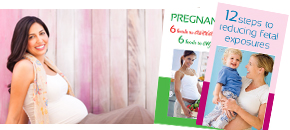Reducing Fetal Exposures
Archived studies and news reports that expand the scope of Environment & Human Health, Inc.'s (EHHI) research reports about health and the environment.
EHHI Calls for More Responsible Management to Protect Children and Pregnant Women
Environment and Human Health, Inc.'s (EHHI) calls for tougher standards to regulate exposures in for children and pregnant women. The weight of scientific evidence supports stronger precautionary regulation by the federal government.
EHHI Releases Endocrine Disruptors: Reduce Exposures, Especially During Pregnancy
The new publication calls for major reductions of endocrine-disrupting chemicals. Endocrine disruptors (EDs) are chemicals that interfere with the normal function of the endocrine system, a network of glands and organs that secrete hormones. While it is true that endocrine-disrupting chemicals are now ubiquitous in our environment, understanding where they can be found makes it easier to avoid many of them and reduce exposures, especially during pregnancy. Download the brochure and read the press release here.
Two brochures from Environment and Human Health, Inc. (EHHI) warn pregnant women what toxic exposures to avoid, what foods to eat and what foods to avoid. EHHI previously published a brochure entitled 12 Steps to Reducing Fetal Exposures. That publication warns pregnant women to try to avoid exposures to paints, toxic cleaning products and cell phones carried near their stomachs. In addition, avoiding pesticide exposures during pregnancy is particularly important. Now EHHI has produced another brochure for pregnant women: Pregnant? 6 Foods to Avoid and 6 Foods to Enjoy. A grant from the Connecticut Health Foundation has, in part, made the latter effort possible.
Most Pregnant Women Aren't Warned about Chemicals by Their Doctors
A University of California San Francisco survey of 2,600 obstetricians and gynecologists nationwide showed that most do not warn their pregnant patients about chemicals in food, consumer products or the environment that could injure their unborn children. More than half said they don't warn about mercury, while very few give advice about lead, pesticides, air pollution, or chemicals in plastics or cosmetics. Click here for news story.
Phthalates potentially alter levels of a pregnancy hormone that influences sex development
Exposure to hormone-altering chemicals called phthalates — found in many plastics, foods and personal care products — early in pregnancy is associated with a disruption in an essential pregnancy hormone. The chemical adversely affects the masculinization of male genitals in the baby, according to research led by the University of Pittsburgh Graduate School of Public Health. Click here for news story.
News items are not independently verified by EHHI and inclusion on this site does not constitute an endorsement.
EHHI's Pregnancy Brochures
Although obstetricians warn pregnant women not to drink alcohol and not to smoke during pregnancy, we are learning that there are other chemicals and products that women should be careful about during those critical nine months. The Environmental Working Group found more than 200 chemicals in the cord blood of babies tested right after birth.
For further information about fetal exposures, click here or download 12 Steps to Reducing Fetal Exposures and Pregnant? 6 Foods to Avoid and 6 Foods to Enjoy.
Endocrine-disrupting chemicals are now ubiquitous in our environment, but understanding where they can be found makes it easier to avoid many of them and reduce exposures, especially during pregnancy. Download Endocrine Disruptors: Reduce Exposures, Especially During Pregnancy and read the press release here.

